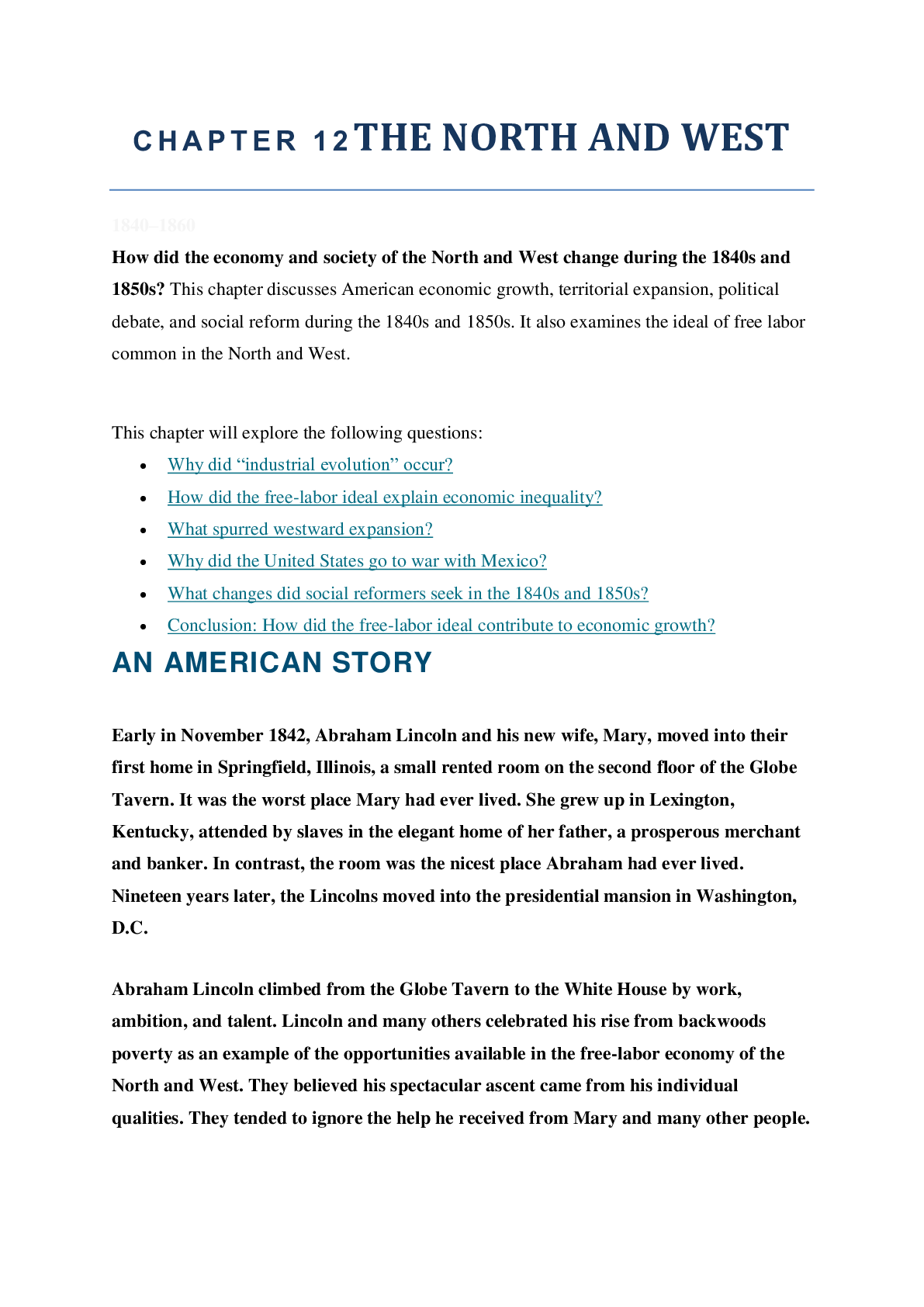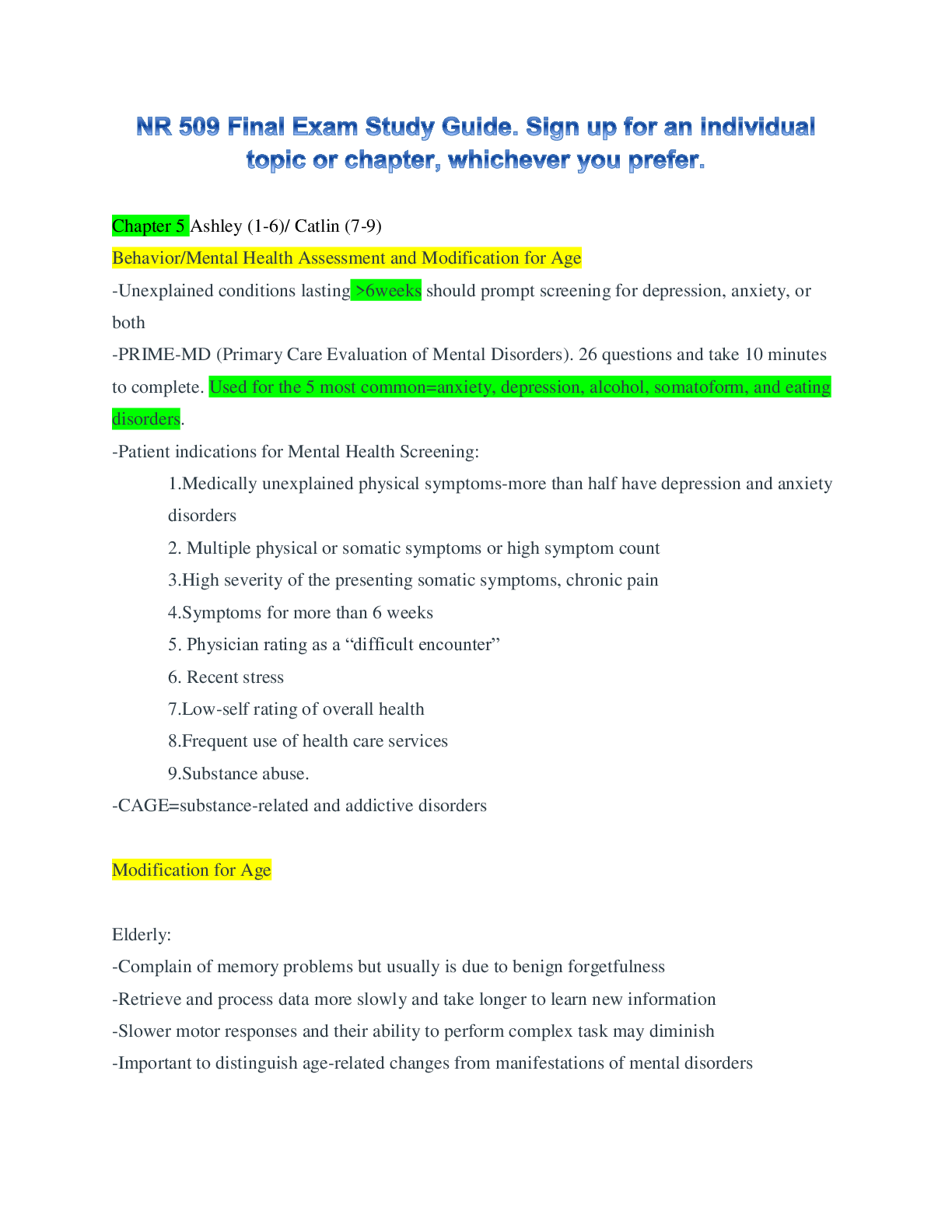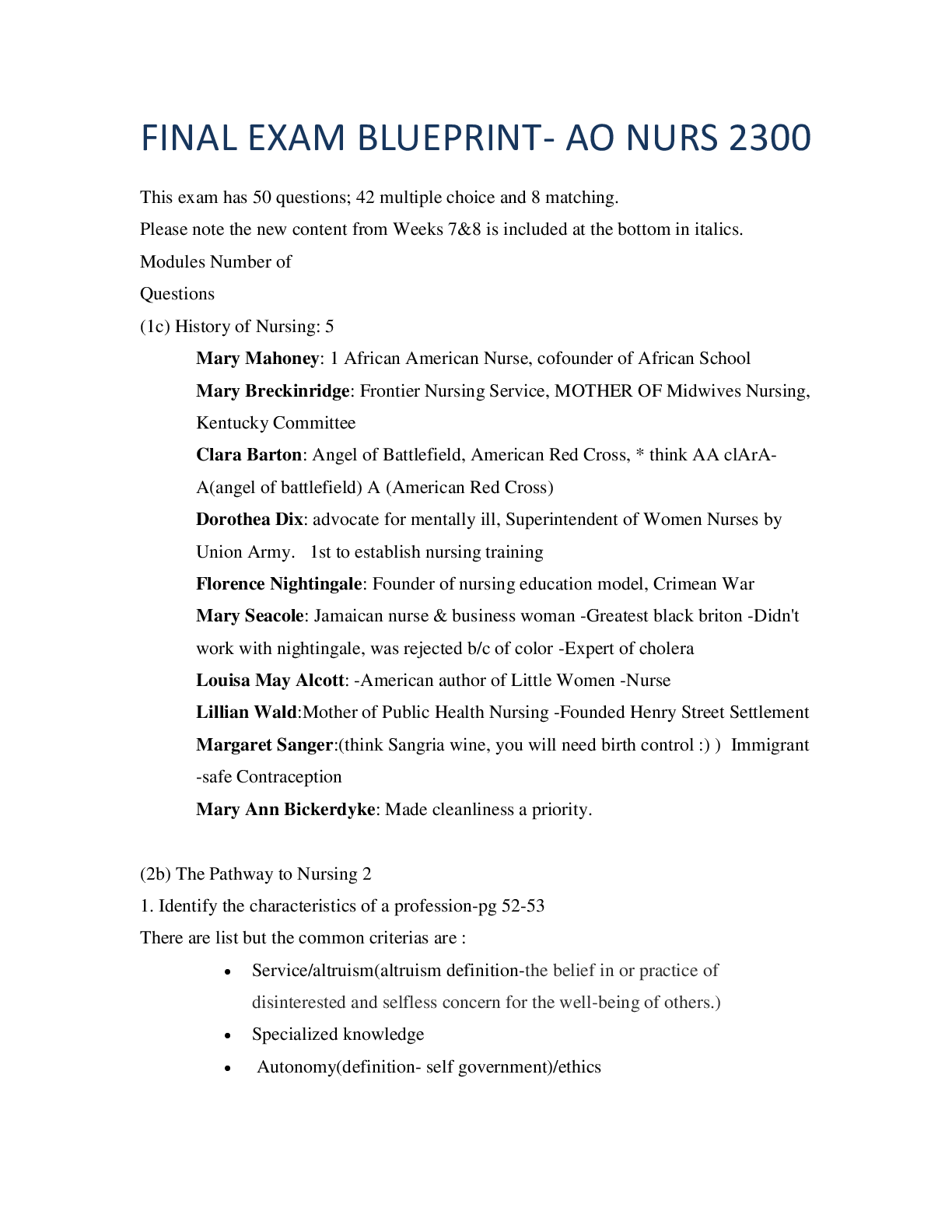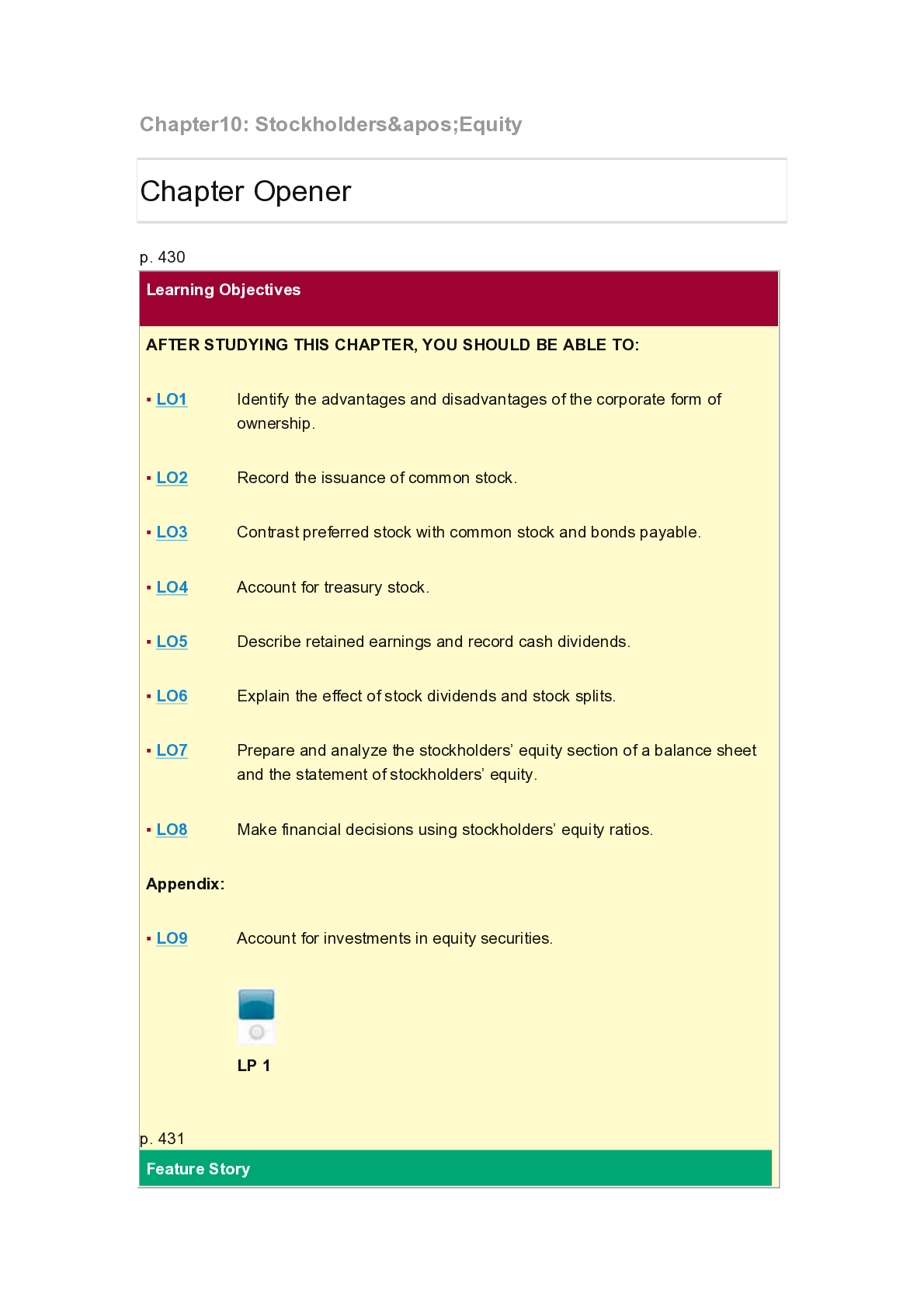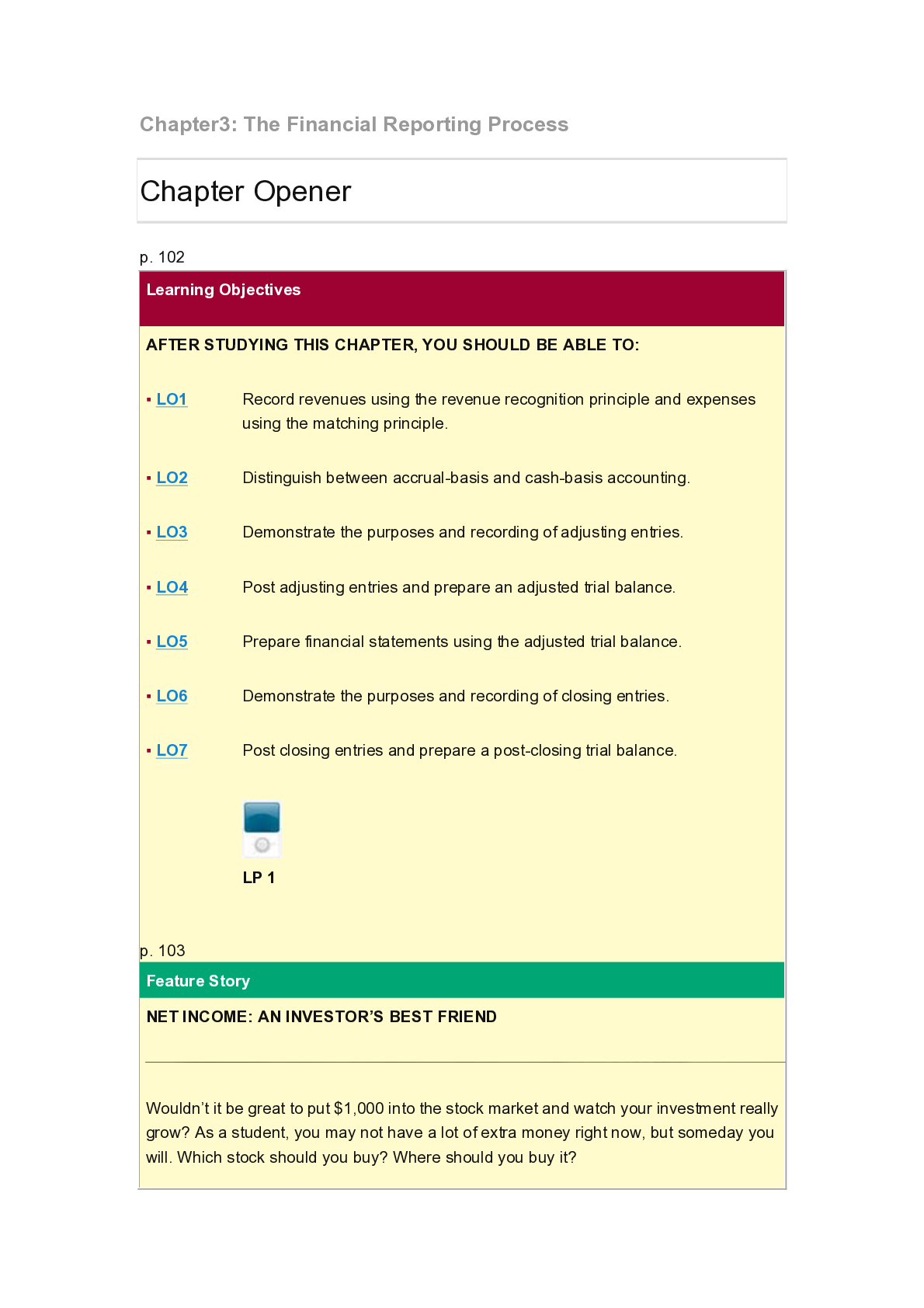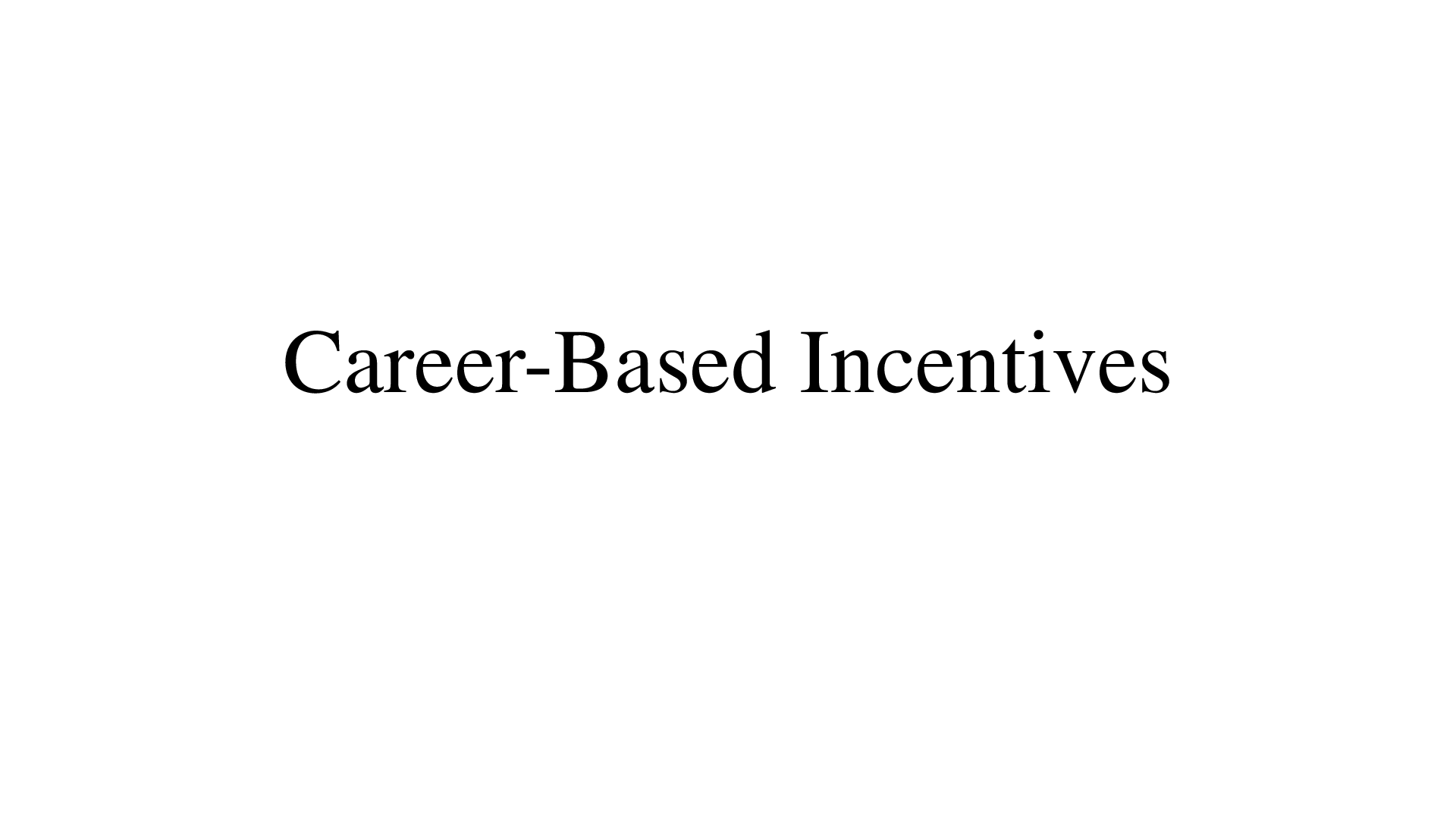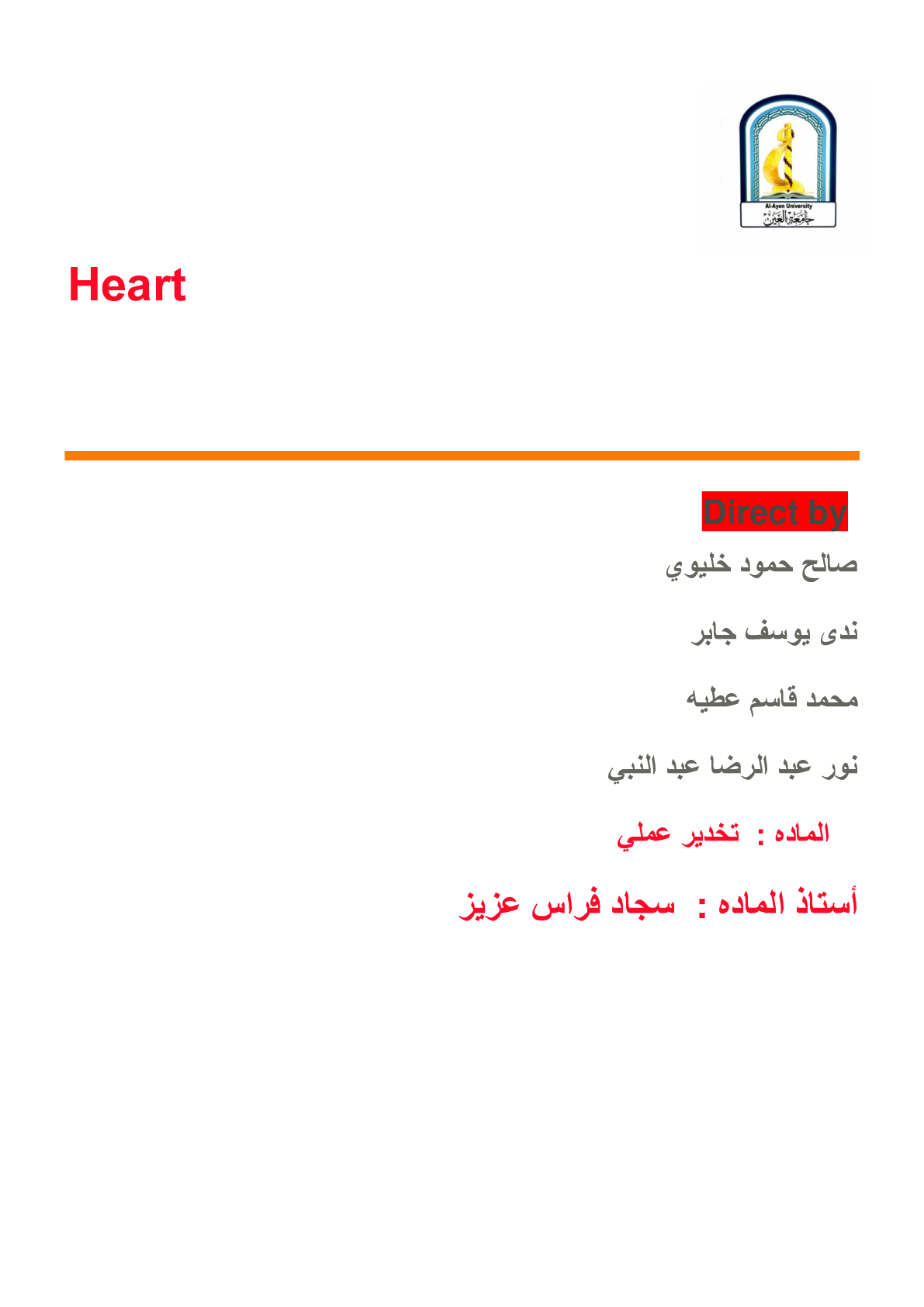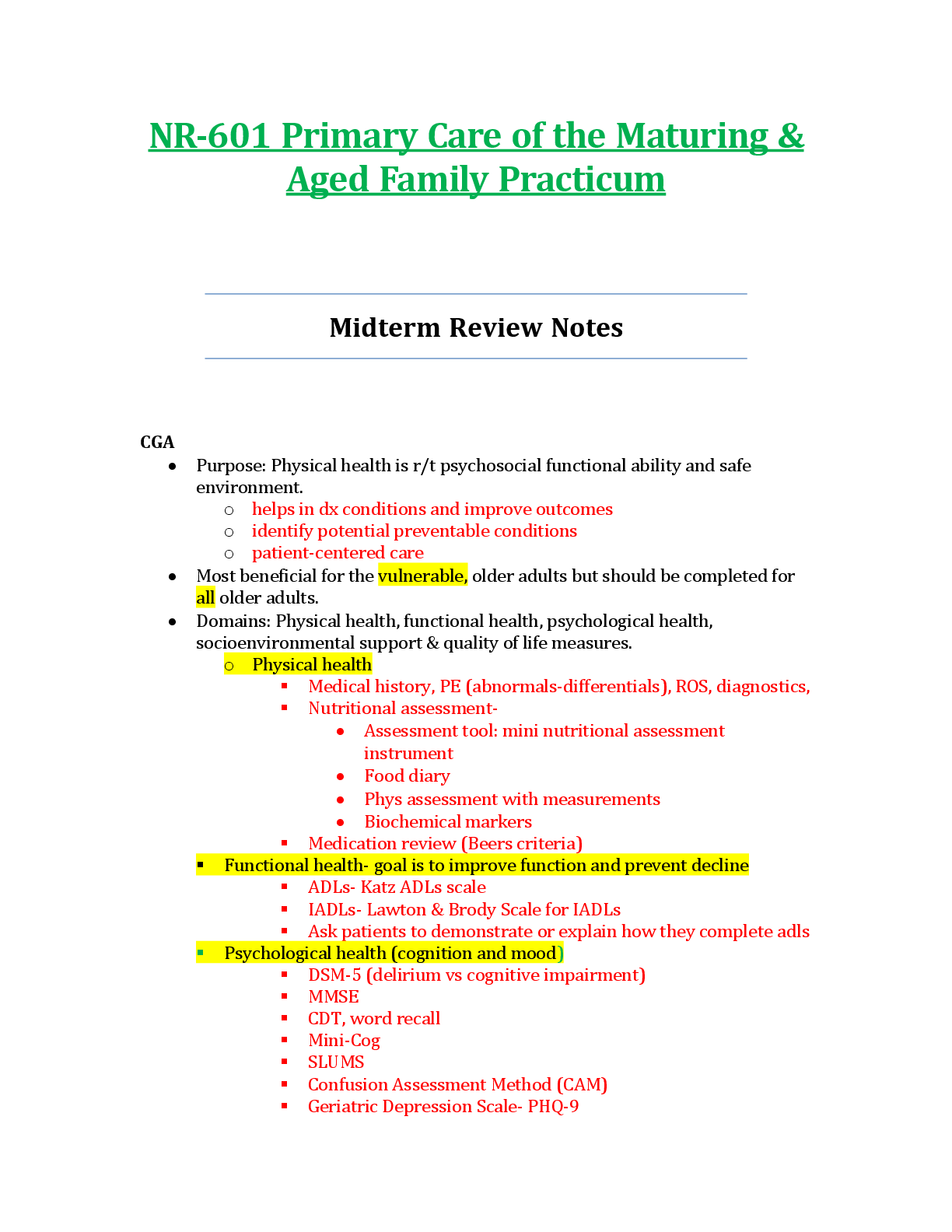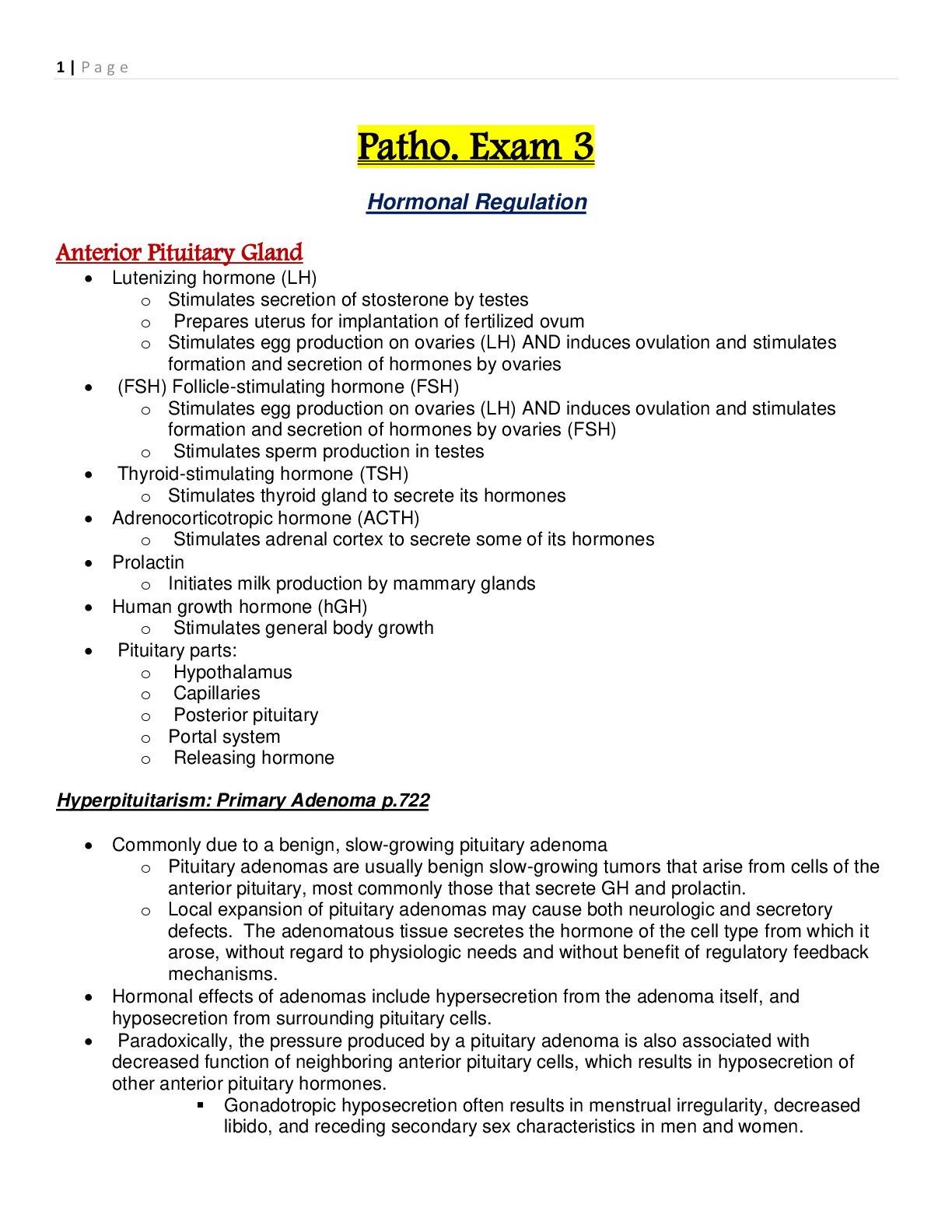*NURSING > Study Notes > PLEURAL EFFUSIONS: MALIGNANT. Study Notes. With Questions, Answers and the Rationale (All)
PLEURAL EFFUSIONS: MALIGNANT. Study Notes. With Questions, Answers and the Rationale
Document Content and Description Below
PATHOPHYSIOLOGICAL MECHANISMS EPIDEMIOLOGY AND ETIOLOGY Table 38-1 MALIGNANT NEOPLASMS ASSOCIATED WITH PLEURAL EFFUSION*From Abeloff, M. D., Armitage, J. O., & Niederhuber, J. E., et al. (Eds.). ( ... 2004). Clinical oncology. (3rd ed.). New York: Churchill Livingstone. *Includes causes of malignant effusion each less than 1%: Endocrine, head and neck cancer; mesothelioma; soft tissue sarcoma; bone cancer; and myeloma. Cause Number Percentage Total malignant effusions 1283 100 Lung cancer 450 35 Breast cancer 246 20 Lymphomas and leukemia 256 20 Unknown primary (adenocarcinoma) 154 12 Unknown primary (all types) 95 7 Reproductive tract 70 5 Gastrointestinal tract 90 7 Genitourinary tract 66 5 All other 39 3 RISK PROFILE PROFESSIONAL ASSESSMENT CRITERIA (PAC) NURSING CARE AND TREATMENT 1. Vital signs: Assess for hypertension, tachycardia, tachypnea, chest discomfort, or fever. 2. Obtain and interpret O2 saturation values. 3. Administer oxygen as needed. 4. Assess for nonproductive cough. EVIDENCE-BASED PRACTICE UPDATES TEACHING AND EDUCATION Dyspnea: Rationale: Activity: Rationale:. Nutrition: Rationale: Eat small,. Tests and procedures: Rationale: You may need additional chest x-ray films to assess for Web sites for information: • American Thoracic Society: www.thoracic.org • Lung Cancer: www.lungcancer.org • American Cancer Society: www.cancer.org • Oncology Nursing Society: www.ons.org NURSING DIAGNOSES EVALUATION AND DESIRED OUTCOMES DISCHARGE PLAN AND FOLLOW-UP CARE . QUESTIONS 1. Malignant pleural effusions are most frequently related to: 1. Lung cancer 2. Colon cancer 3. Leukemia 4. Breast cancer 2. An early presenting symptom of pleural effusion is: 1. Nausea 2. Fever 3. Shortness of breath 4. Weight gain 3. Mr. K. is a 66-year-old male who was diagnosed with stage III non-small cell lung cancer. He received chemotherapy and radiation to the chest and completed treatment 8 months ago. He presents to your clinic with complaints of increasing shortness of breath, right-sided chest discomfort, and cough. You suspect a pleural effusion. You anticipate assessment findings that correlate with pleural effusion, including: 1. Hypotension and fever 2. Brachypnea and bradycardia 3. Oxygen saturation less than 96% 4. Decreased breath sounds in the right lower lobe 4. Mr. K. is sent for a chest x-ray film. A chest x-ray film confirming a pleural effusion would reveal: 1. Fibrotic streaking 2. Costophrenic angle blunting 3. Cardiomegaly 4. Water bottle–shaped pericardium 5. Mr. K. has a thoracentesis for pleural fluid analysis and symptom management. Mrs. K. asks you what caused the fluid in his lung. After reviewing the report on the pleural fluid analysis, you tell Mrs. K. the results suggest that the fluid is most likely malignant. Your statement is based on the knowledge that malignant pleural fluid has the following characteristic: 1. Clear, light yellow color 2. High pH (greater than 7.3) 3. Elevated cell count 4. Elevated LDH 6. Mr. K. remains short of breath after the thoracentesis. Your nursing care should include: 1. Elevate the head of the bed to reduce pressure on the chest 2. Measure the O2 saturation and administer oxygen 3. Administer morphine sulfate 4. All of the above 7. Mrs. K. voices concern about being able to care for Mr. K. at home. To assist Mrs. K., you would recommend: 1. Nursing home placement 2. Physical therapy 3. Referral to home care nursing or home hospice care 4. Occupational therapy 8. Mr. and Mrs. K. decide to go home with hospice care. Mrs. K. should be instructed to notify the home care or hospice nurse if Mr. K. experiences: 1. Hemoptysis 2. Increasing shortness of breath 3. Loss of appetite 4. Distressing symptoms 9. Discharge instructions for Mr. K. would include: 1. Use oxygen only at night. 2. Prepare low-calorie meals if weight gain occurs. 3. Encourage Mr. K. to perform activities of daily living. 4. The rationale for using morphine sulfate for dyspnea. 10. The hospice nurse visits and finds Mr. K. sitting in a chair, holding his right ribs. The nurse’s assessment is: BP 160/100, temperature 98.7, pulse 120, shallow respirations 22, decreased tactile fremitus and decreased breath sounds in the right lung. The appropriate nursing action would be: 1. Reposition Mr. K. with pillows 2. Administer oxygen, 2 to 4 L/nasal cannula 3. Administer morphine sulfate 4. All of the above REFERENCES C.S. Grove, Y.C Lee, Vascular endothelial growth factor: The key mediator in pleural effusion formation, Current Opinions in Pulmonary Medicine 8 (2002) 294–301. R.W Light, Pleural effusion, New England Journal of Medicine 25 (2002) 1971–1977. Niedrehuber, et al. (Eds.), Clinical oncology (pp. 1179 1212). New York: Churchill Livingstone. N., Noppen, M.R., DeWaele, R., Li, et al., Volume and cellular content of normal pleural fluid in humans examined by pleural lavage, American Journal of Respiratory Critical Care Medicine 162 (2000) 1023–1026. J.S Pollak, Malignant pleural effusions: Treatment with tunneled long-term drainage catheter, Circulation Opinion in Pulmonary Medicine 8 (2002) 302–307. D.S. Schrump, D.M Nguyen, Malignant pleural and pericardial effusions, In: (Editors: V.T. DeVita, S. Hellman, S.A. Rosenberg) Cancer: Principles and practice of oncology 6th (2001) Lippincott Williams & Wilkins, Philadelphia, pp. 2729–2744 . Shaw, P., & Agarwal, R. (2004). Pleurodesis for malignant pleural effusions. Cochrane Database of Systematic Reviews, 1:CD002916. Retrieved: May 1, 2007 from www.cochrane.org/reviews/-18K. K. Shuey, Y Payne, Malignant pleural effusion, Clinical Journal of Oncology Nursing 9 (2005) 529–532. D.L. Walker, D.A Casciato, Malignant effusions, In: (Editor: C.M. Haskell) Cancer treatment 5th (2001) W. B. Saunders, Philadelphia, pp. 1578–1590. [Show More]
Last updated: 3 years ago
Preview 1 out of 10 pages
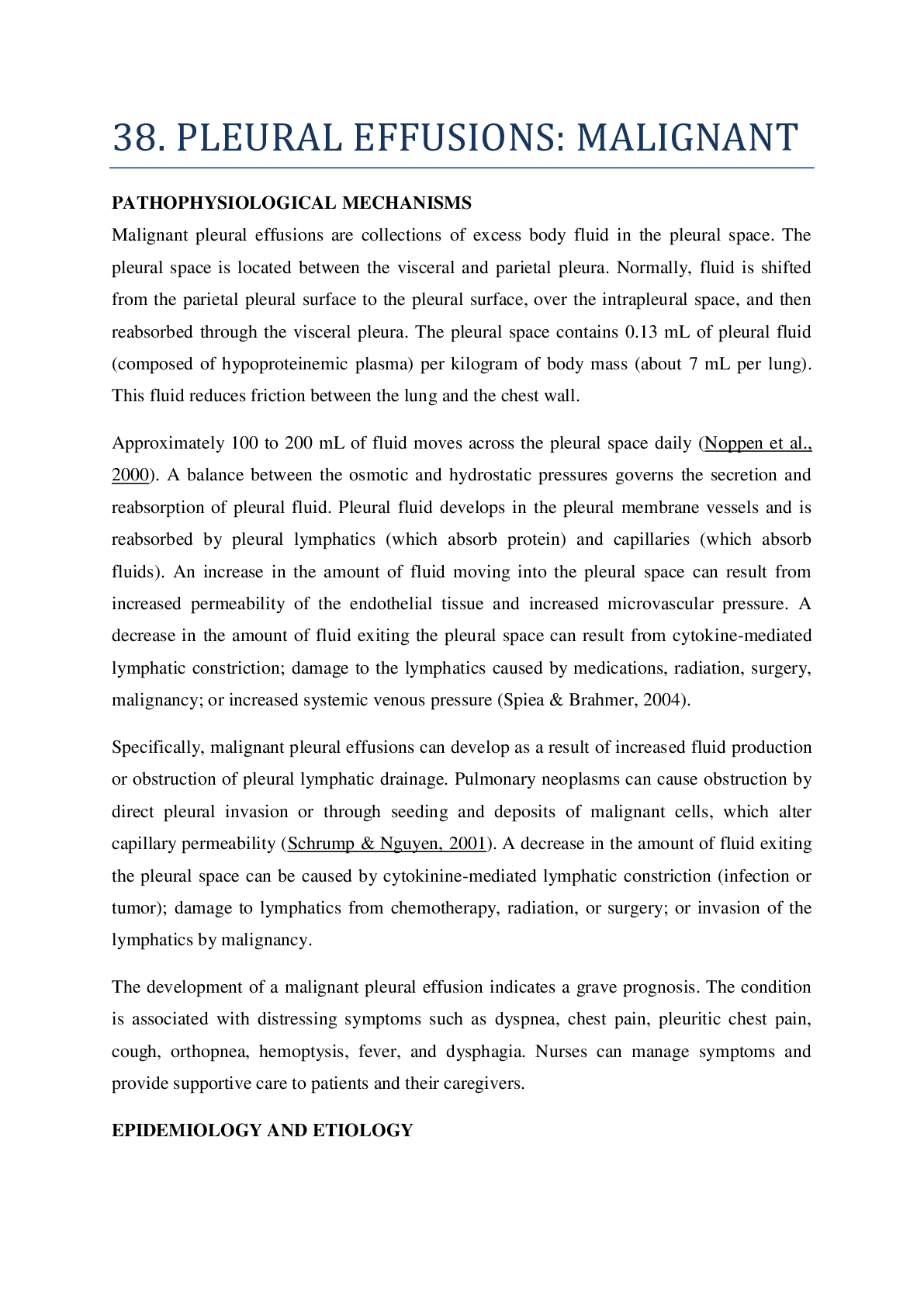
Buy this document to get the full access instantly
Instant Download Access after purchase
Buy NowInstant download
We Accept:

Reviews( 0 )
$5.00
Can't find what you want? Try our AI powered Search
Document information
Connected school, study & course
About the document
Uploaded On
May 25, 2020
Number of pages
10
Written in
All
Additional information
This document has been written for:
Uploaded
May 25, 2020
Downloads
0
Views
98

